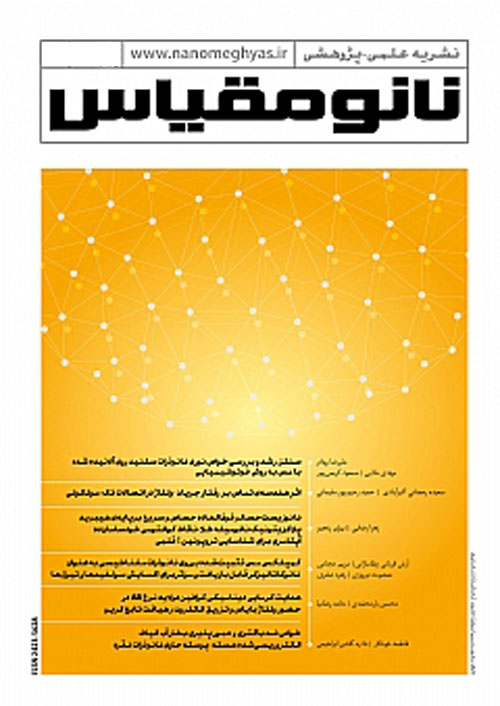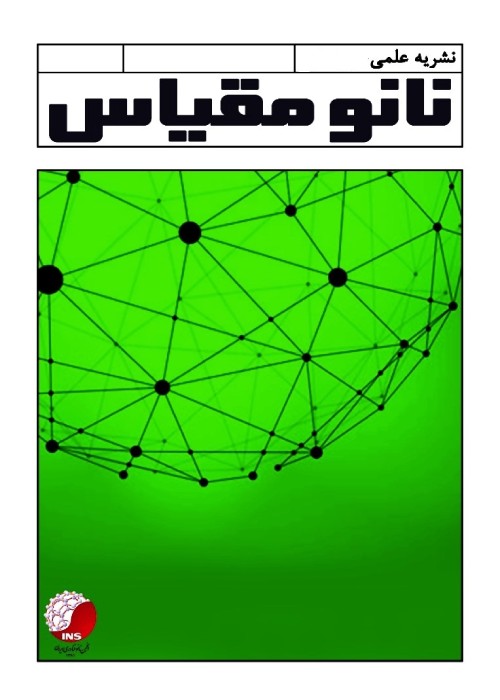فهرست مطالب

فصلنامه نانو مقیاس
سال دوم شماره 3 (پیاپی 7، پاییز 1394)
- تاریخ انتشار: 1394/08/30
- تعداد عناوین: 6
-
-
نانوزیست حسگر فوق العاده حساس و سریع بر پایه ی هیبرید پلاگزیتونیک نانومیله طلا-کوانتوم دات RQ خودسازمان ده آپتامری برای شناسایی تروپونین I قلبی انسانیصفحه 3سکته ی حاد قلبی یکی از علل اصلی مرگ ومیر در سراسر جهان است. روش های متداول تشخیص سکته ی قلبی پرهزینه و زمان بر هستند و معمولا از نمونه ی خون به عنوان نمونه ی زیستی استفاده می کنند؛ بنابراین، ساخت یک ابزار تشخیصی فوق العاده سریع، حساس و غیرتهاجمی ضروری به نظر می رسد. در این تحقیق یک نانوزیست حسگر جدید فوق العاده حساس و فلورسنت پلاگزیتونیک آپتامری که از جفت شدگی پلاسمون-اگزایتون هیبرید نانومیله ی طلا-کوانتوم دات RQ ساخته شده است، جهت تشخیص پروتئین انسانی تروپونین I قلبی cTnI، بیومارکر طلایی تشخیص سکته ی حاد قلبی، معرفی می گردد. آزمایش های پیش-بالینی با کمک بزاق انجام گرفت. اتصال پروتئین cTnI به آپتامر منجر به تشدید فلورسانس سامانه هیبرید پلاگزیتونیک می شود. حد تشخیص این نانوزیست حسگر نیم فمتومولار است. به نظر می رسد که این نانوزیست حسگر جدید بر پایه ی سامانه هیبرید پلاگزیتونیک RQ، می تواند پنجره ی جدیدی را به سوی فرصت های تازه برای توسعه ی طراحی و ساخت نانو زیست حسگرها در حوزه ی نانوزیست فناوری باز کند.کلیدواژگان: آپتامر، تروپونین I قلبی انسانی، سکته ی حاد قلبی، کوانتوم دات، نانوزیست حسگر، نانومیله ی طلا
-
خواص ضدباکتری و عبورپذیری الیاف الکتروریسی شده هسته-پوسته حاوی نانوذرات نقرهصفحه 6در این تحقیق، روش الکتروریسی هم محور برای تهیه الیاف هسته-پوسته پلی کاپرولاکتان PCL و پلی وینیل الکل PVA استفاده شد و نانوذرات نقره قبل از فرایند، از طریق احیای نیترات نقره درون محلول هسته، اضافه شد. حضور نانوذرات نقره با مشاهده پیک جذبی در آزمون طیف نمایی مرئی-فرابنفش در محدودهnm 430-420 ثابت شد. خواص ضدباکتری طبقاستانداردATCC 100 با استفاده از باکتری E.coliو S.aureusبر روی بافت الیاف تک لایه PCL، PVA، PCL حاوی نقره،PVA حاوی نقره و بافت الیاف هسته-پوستهPVA-Ag/PCL و PCL-Ag/PVAبررسی شد. نتایج نشان داد الیاف هسته-پوسته همانند الیاف تک لایه حاوی نقره خواص ضدباکتری قوی دارد.به علاوه افزودن نانوذرات نقره موجب افزایش اندک زاویه تماس یا آب گریزی الیاف می شود.آزمون نرخ عبور بخار آب نشان داد با افزون نقره و هسته-پوسته شدن الیاف مقدار WVTRکاهش یافته که این مقدار نسبت به زخم بندهای تجاری موجود، به مقدار WVTRپوست انسان نزدیک تر است.کلیدواژگان: الکتروریسی، پلی کاپرولاکتان، پلی وینیل الکل، خواص ضدباکتری، نیترات نقره
-
صفحه 117در این مقاله نانوبلورهای سلنید روی آلائیده شده با مس به وسیله یک روش فوتوشیمیایی ساده سنتز شدند. نتایج XRD و TEM تشکیل نانوذرات آلائیده شده با فاز زینک بلند و اندازه ذرات nm3 را نشان داد با توجه به آنالیز UV-Vis گاف انرژی نانوذرات آلائیده شده با مس از 3/80 به eV 3/45 برای مدت زمان سنتز 5 تا 15 دقیقه کاهش یافت. طیف نورتابی برای نانوذرات ZnSe سنتز شده دو قله که به ترتیب مربوط به گذار اکسیتونی و گذار از نوار رسانش به تله های مربوط به نواقص بلوری هستند را نشان داد. برای نانوذرات سلنید روی آلائیده شده با مس قله مربوط به گذارهای اکسیتونی و تله ای با گذشت زمان یه ترتیب کاهش وافزایش یافتند، بطوریکه در مدت زمان 10 دقیقه گسیل اکسیتونی کاملا خاموش شده و گسیل تله ای به بیشینه مقدار خود رسید.کلیدواژگان: سلنید روی، فوتوشیمیایی، آلایش با مس، نورتابی
-
صفحه 125در این مقاله، ترابرد الکترون در یک سیستم مولکولی فلز/مولکول/فلز شامل مولکول بای فنیل دی سیئول و الکترودهای طلا، برای سه هندسه ی اتصال مختلف بررسی شده است. در این پژوهش هامیلتونی مولکول با استفاده از روش هاکل محاسبه شده است. فرمول بندی مورد استفاده بر پایه روش تابع گرین غیرتعادلی و در چارچوب فرمول بندی لاندائو و بوتیکر می باشد. نمودارهای ضریب عبور و جریان-ولتاژ، برای سه ساختار هندسی گوناگون محاسبه شده است. نتایج نشان می دهند که انتقال الکترون به شدت تحت تاثیر اثر تداخل کوانتومی امواج گذرنده و هندسه فصل مشترک مولکول و الکترودها است. دامنه جریان در حالت متقارن بیش تر از دو حالت غیرمتقارن می باشد که دلیل این امر اثر تداخل کوانتومی امواج الکترونی گذرنده از شاخه های گوناگون مولکول است.کلیدواژگان: اتصالات مولکولی، تابع گرین غیرتعادلی، نظریه هاکل گسترش یافته، هندسه اتصالات
-
صفحه 141در این تحقیق کمپلکس مس IIتثبیت شده روی نانوذرات مغناطیسی اکسید آهن بعنوان کاتالیروز موثر، کارامد و قابل بازیافت سنتز شد. این نانو ذرات برای اکسایش سولفید به سولفوکسید و واکنش های جفت کردن اکسایشی تیول ها به دی سولفیدها در حضور هیدروژن پراکسید بعنوان عامل اکسنده، مورد استفاده قرار گرفت. گسترده وسیعی از سولفید ها و تیول های آروماتیک و آلیفاتیک با موفقیت به محصولات مورد نظر تبدیل شدند. همه محصولات با بازده عالی تا خوب به دست آمدند. نانو کاتالیزور های مغناطیسی با تکنیک های مختلفی شامل : SEM، TEM، XRD، VSM، TGA، EDX ،IR تعیین مشخصات شده اند. مزیت استفاده از نانو ذرات اکسید آهن، جداسازی آسان کاتالیزور از محیط واکنش با استفاده از یک میدان مغناطیسی خارجی است که قابلیت استفاده مجدد و انجام واکنش با بازده بالا را امکان پذیر می سازد.کلیدواژگان: اکسایش، تیول، سولفید، کمپلکس مس، نانوذرات مغناطیسی
-
صفحه 151رفتار هدایت گرمایی گرافین دولایه نوع AA که الکترون به آن تزریق شده است و تحت ولتاژ بایاس قرار گرفته است بعنوان تابعی از بسامد فوتونی را با استفاده از مدل هامیلتونی تنگ بست بررسی کرده ایم. در این کار گرادیان دمای وابسته به بسامد در نظر گرفته شده است. هدایت حرارتی این دستگاه با استفاده از رهیافت تابع گرین در تقریب پاسخ خطی کوبو مورد بررسی قرار گرفته است. بسته به نواحی متفاوت بسامد، رفتارهای مختلفی برای هدایت گرمایی دیده می شود. همچنین وابستگی هدایت گرمایی دینامیکی به ولتاژ بایاس و دما بررسی شده است. با افزایش پتانسیل شیمیایی، ولتاژبایاس و دما هدایت گرمایی دینامیکی سیستم کاهش یافته است، درصورتیکه با افزایش بسامد این کمیت در پتانسیل بایاس و دمای بالا دارای یک افت وخیز نسبی می باشد.کلیدواژگان: هدایت گرمایی دینامیکی، گرافین دولایه، تابع گرین
-
Ultra-Sensitive, Rapid Gold Nano Rod-Quantum Dot (RQ) Plexcitonic Self-Assembled Aptamer-based Nanobiosensor for the Detection of Human Cardiac Troponin IPage 3Acute Myocardial Infarction AMI is one of the leading causes of death throughout the world. Usual methods for detecting AMI are expensive, time-consuming and using blood samples as biological samples. Therefore, creating an ultra-fast, sensitive and non-invasive diagnostic test is necessary. Herein, a novel ultra-sensitive, fluorescent, plasmon-exciton coupling hybrid of a Gold Nano Rod-Quantum Dot RQ -based aptamer nanobiosensor is presented for the detection of human cardiac troponin I cTnI, the golden biomarker of AMI, and a preclinical test is performed with saliva. The binding of the cTnI protein to aptamer leads to a fluorescence enhancement of the plexcitonic hybrid system. The limit of detection of this nanobiosensor is 0.5 fM. It seems this novel nanobiosensor of the RQ plexcitonic hybrid system can open up new opportunities for the design and fabrication of nanobiosensor progress in nanobiotechnology.Keywords: Acute Myocardial Infarction, Aptamer, Gold Nano Particle, Human Cardiac Troponin I, Nanobiosensor, Quantum Dot
-
Antibacterial and Water Vapor Transmission Properties of Core-Shell Electrospun Fibers Containing Silver NanoparticlesPage 6In this research, coaxial electrospinning method was used for preparing the core-shell fibers of polycaprolactone PCL and polyvinyl alcohol PVA, and silver nanoparticles were added through the reduction of silver nitrate in core solution before processing. The presence of silver nanoparticles was proved by observing the absorption peak in UV-visible spectroscopy test in the range of 420-430 nm. Antibacterial properties were investigated according to ATCC100 standard by usage of E.coli and S.aureus bacteria on single layer fibers mat of PCL, PVA, PCL containing silver and PVA containing silver, as well as core-shell fibers mat of PVA-Ag/PCL and PCL-Ag/PVA. The results showed that core-shell fibers have strong antibacterial properties like single layer fibers containing silver. Also, adding silver nanoparticles caused a slight enhancement in contact angle or hydrophobicity of the fibers. The water vapor transmission rate test exhibited that WVTR value decreased with the addition of silver and fabricating core-shell fibers while in comparison with commercial wound dressing, this value is more close to human WVTR value.Keywords: Electrospinning, Polycaprolactone, Polyvinyl alcohol, Antibacterial Properties, Silver Nitrate
-
Page 117In the present work, Cu-doped ZnSe Nanocrystals NCs were synthesized by a simple photochemical method. XRD and TEM analysis demonstrated zinc blende phase NCs with an average size of around 3 nm. UV-Vis analysis showed decreasing the band gap of ZnSe NCs from 3.80 to 3.45 eV for 5 to 15 min illumination time. Photoluminescence spectra of ZnSe NCs showed a broad emission with two peaks located at 380 and 490 nm related to excitonic and trap states emission, respectively. For ZnSe:Cu NCs, excitonic emission was decreased and PL intensity of trap states emission increased and for 10 min illumination, excitonic emission quenched completely and trap states emission reached to its maximum value.Keywords: ZnSe, Photochemical, Cu doping, Photoluminescence
-
Page 125In this paper, electron transport in a metal/molecule/metal molecular system Includes biphenyl-dithiol molecule and three-dimensional gold electrodes for three different types of contact geometry, are investigated. The Hamiltonian of the molecule is calculated based on the Hückel method and the current is computed by the non-equilibrium Greens function method in the framework of LandauerBüttiker formalism. Transmission coefficient and current-voltage characteristics are calculated for three different geometric structures. The results show that electron transport is strongly affected by quantum interference of electron waves and the geometry of the molecule-electrode interface. The current amplitude for symmetric coupling is larger than two other asymmetric couplings because of the quantum interference effects of the electron waves traveling through the different paths.Keywords: Molecular junctions, Extended Huckel theory, Non, equilibrium Green's function, Junction geometry
-
Page 141Supported copper II on functionalized Fe3O4 magnetic nanoparticles was used as high efficient and magnetically recoverable catalyst for the oxidation of sulfides to sulfoxides and oxidative coupling of thiols into corresponding disulfides using hydrogen peroxide H2O2 as oxidant. An aliphatic and aromatic series of sulfides and thiols including various functional groups was successfully converted into corresponding products. All of products were obtained in good to excellent yields. The magnetic nanocatalyst was characterized by FT-IR spectroscopy, TEM, XRD, SEM, and TGA techniques. Recovery of the catalyst is easily performed via magnetic decantation and reused for several consecutive runs without significant loss of its catalytic efficiency and activity.Keywords: Magnetic Nanoparticle, Copper (II), Oxidation, Sulfide, Thiol
-
Page 151We have investigated the behavior of dynamical thermal conductivity of doped biased bilayer graphene for AA-stacking as a function of frequency in the context of tight-binding model Hamiltonian. In this work, it has considered frequency dependence of temperature gradient. Greens function approach has been implemented to find the behavior of thermal conductivity of bilayer graphene within Kubo linear response theory. Different behaviors have been seen for thermal conductivity due to different frequency. Also thermal conductivity versus bias and temperature has investigated. Dynamical thermal conductivity decreases with chemical potential, bias voltage and temperature, while it has a relative fluctuation with frequency at high bias voltage and high temperature.Keywords: Dynamical thermal conductivity, Bilayer graphene, Green's function


